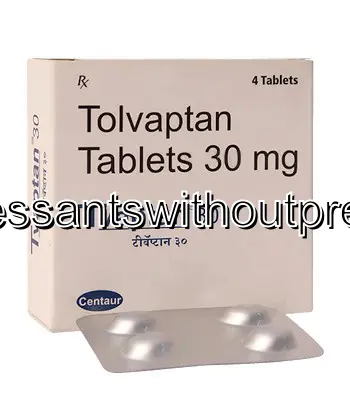| Package | Dosage | Price | Price per Dose | |
|---|---|---|---|---|
| Dosage: 15mg | ||||
| 180 pill | 15mg | $1,693.87 | $9.41 | |
| 120 pill | 15mg | $1,148.38 | $9.57 | |
| 90 pill | 15mg | $875.64 | $9.73 | |
| 60 pill | 15mg | $593.32 | $9.89 | |
| 30 pill | 15mg | $301.44 | $10.05 | |
| 20 pill | 15mg | $204.14 | $10.21 | |
| 10 pill | 15mg | $103.66 | $10.37 | |
| Dosage: 30mg | ||||
| 120 pill | 30mg | $1,496.09 | $12.47 | |
| 90 pill | 30mg | $1,142.00 | $12.70 | |
| 60 pill | 30mg | $775.15 | $12.92 | |
| 30 pill | 30mg | $390.76 | $13.03 | |
| 20 pill | 30mg | $263.16 | $13.16 | |
| 10 pill | 30mg | $132.37 | $13.24 | |

Tolvaptan Description
Introduction to Tolvaptan
Tolvaptan is a medication commonly used to manage specific medical conditions related to fluid balance in the body. It belongs to a class of drugs known as vasopressin receptor antagonists, which work by blocking the action of vasopressin, a hormone that helps regulate water retention. By inhibiting vasopressin, Tolvaptan promotes an increase in urine production, helping to reduce excess fluid accumulation in patients.
Uses and Benefits
This medication is primarily prescribed for the treatment of hyponatremia, a condition characterized by low sodium levels in the blood. Hyponatremia can occur in various contexts, including heart failure, liver disease, or certain types of kidney problems. Tolvaptan effectively raises blood sodium levels in these patients. Moreover, it is also used in the management of autosomal dominant polycystic kidney disease (ADPKD), where it helps slow the growth of cysts and preserves kidney function over time.
Mechanism of Action
Tolvaptan works by selectively blocking vasopressin V2 receptors in the kidneys. This blockade prevents vasopressin from exerting its usual water-retaining effects. As a result, the kidneys excrete more free water while maintaining sodium and other electrolytes. This mechanism helps correct water imbalance without causing significant loss of electrolytes, making it an effective treatment for disorders characterized by water retention and dilutional hyponatremia.
administration and Dosage
Patients typically take Tolvaptan orally, once daily or as prescribed by their healthcare provider. The dosage depends on the condition being treated, the severity of symptoms, and individual response to the medication. It is important to follow the prescribed dose and gradually adjust it based on medical advice. Regular monitoring of blood sodium levels is necessary during therapy to prevent potential complications like overly rapid correction of hyponatremia.
Potential Side Effects
While Tolvaptan is effective, it may cause some side effects. Common adverse reactions include thirst, dry mouth, increased urination, and dizziness. In some cases, patients may experience gastrointestinal symptoms like nausea or constipation. Because of its action on water balance, there is also a risk of too rapid correction of sodium levels, which can lead to serious neurological issues. Rare but serious side effects include liver injury, necessitating regular liver function tests during treatment.
Precautions and Interactions
Patients with liver disease, those taking other medications affecting water and electrolyte balance, or with specific kidney disorders should use Tolvaptan with caution. It is essential to inform the healthcare provider about all medications being taken to avoid drug interactions. Additionally, careful monitoring of blood chemistry is vital to prevent complications such as overly rapid sodium correction or dehydration.
Overall Review
Tolvaptan is a valuable medication for managing hyponatremia and certain kidney diseases. Its targeted mechanism provides effective results with proper medical supervision. However, like all medicines, it requires careful dosage management and monitoring. Patients should adhere strictly to their healthcare provider's instructions to minimize risks and maximize benefits. When used correctly, Tolvaptan can significantly improve quality of life for individuals affected by fluid imbalance-related conditions.
